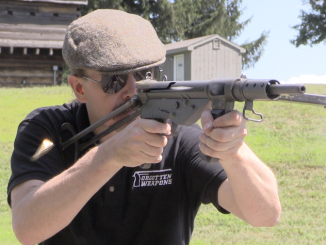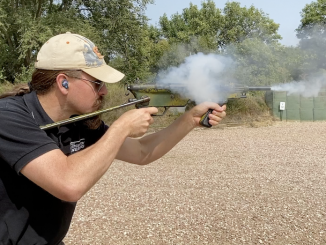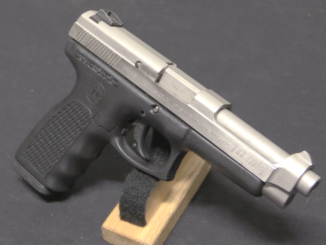The Charlton was a conversion of a bolt action Lee rifle into a light machine gun, designed by New Zealander Phillip Charlton. Some 1500 were made in New Zealand, but a bit later it appears that there was an effort to also produce the gun in Australia. The Electrolux company (the same one that makes washing machines and other home appliances today) made a few prototypes.
The Electrolux version is different from the original in a couple ways. While the basic conversion mechanism is the same, the Electrolux is more refined, with a shorter gas system and a fairly clean action cover oven the working parts. It is also semiautomatic only, intended to be a should rifle where the original was made for the LMG role. Electrolux also used standard No1 MkIII rifles as its base, where the originals were made from a variety of mostly worn out Lee Metfords and Long Lees.
The Electrolux contract was cancelled in June 1944, and only a few prototypes were made. This example is in the British Royal Armouries collection, to whom I am grateful for the access and the trust to take it apart for you!




I’d always wondered what the hell these looked like on the inside, and now I know. I rather wish I was still ignorant…
This is a fascinating example of what can go wrong when you don’t stay on top of small arms development, and leave your nation unready for a modern war. The Australians should have had the sense to either go in with the American Garand program, or one of the Czech rifles before they tried for this sad affair.
It is of a piece with other Antipodean military efforts, though. The sub program comes to mind… What the hell is it about the Southern Hemisphere and small arms? India is another case where they just can’t get out of their own way, when it comes to these things.
I’d love to get Ian’s opinion on the INSAS… That’s nearly an SA80-level small arms debacle, from all I’ve heard.
Oh, and more proof that Australia has issues with small arms? They were the sole major army to adopt the M60… Willingly, from what I’m told. The Aussie Warrant Officer I spent a day or so BS’ing with was of the opinion that our having sold that weapon to them could rightly have been seen as an act of war. Can’t say I didn’t agree with him, either…
“(…)What the hell is it about the Southern Hemisphere and small arms? India is another case where they just can’t get out of their own way, when it comes to these things.(…)”
To my understanding southern-most point of India Cape Comorin is around 8°N, thus rendering India belonging to Northern Hemisphere. Please provide reliable source proving that is not case.
“(…)go in with the American Garand program(…)”
Can you make it using ·303 British cartridge?
“(…)This is a fascinating example of what can go wrong when you don’t stay on top of small arms development, and leave your nation unready for a modern war. (…)”
There were also… unorthodox armoured vehicles created in 1940s in New Zealand due to lack of possibility of sourcing them externally.
https://tanks-encyclopedia.com/ww2/NewZealand/Bob_Semple_Tank.php
https://www.nevingtonwarmuseum.com/new-zealand—schofield-tank-type-i.html
I seem to recall the Owen SMG was very highly rated. That was Aussie wunnit?
“(…)Electrolux company (the same one that makes washing machines and other home appliances today) made a few prototypes.(…)”
This might looks like something untypical, but was not strictly limited to Australia. For example another 1940s self-loading fire-arm known as M1 Carbine was produced by I.B.M. (later known for production of computers) https://smallarmsreview.com/the-ibm-auto-ordnance-m1-carbine/
Almost has a steampunk style to it….very cool as usual Ian, thank you.
The most obvious drawback to the Charlton-Electrolux SL is that it’s too heavy for use as an infantry rifle.
The Charlton automatic rifle (Commonwealth terminology for LMG) weighed 16 lbs (7.27 kg) empty. Not light, but not too heavy for a serious LMG with a 30-round magazine. By comparison, a fully-loaded M1918 BAR weighs 15.98 lbs (7.26 kg) and only has a 20-round magazine vs the 30-rounder on the Charlton. (Advantage Charlton.)
The SL “rifle” weighed 12.5 lbs (5.68 kg) empty. By comparison, a Garand M1 weighed 10.2 lbs (4.64 kg) fully loaded. The SL was just too heavy for a soldier to hump all day and still be able to deliver accurate, aimed fire with. (I know, we know all about “sustained firescreens“, but back then they still had “marksmanship tradition” on their brains.)
Even disregarding its steampunk innards, the SL just did not make sense as a self-loading infantry rifle.
clear ether
eon
Perhaps this is why we’re supposed to invest in better systems from the get-go. I mean, read Kirk’s remarks as to why research and development are always needed, whether you plan to go to war or not. Just imagine what horrible things would have happened if America had been invaded by a fictional aerial empire (fantastic flying continent?) just prior to the Great War (World War One from today’s perspective). At that time, the US Army and the US Navy were on a shoe-string budget if I’m not mistaken, on the premise that complete nonintervention in anything would guarantee that nothing bad would EVER happen to the US. I could be wrong.
Actually the U.S was not invaded by any aerial empire. So your point is what…? That middle aged adolescent weapons fantasizers should set defense policy?
No he’s right. We should always be super duper vigilant in case a fantastic flying continent shows up.
“(…)prior to the Great War(…)US Navy(…)on a shoe-string budget(…)”
Then how they manage to organize so-called Great White Fleet
https://www.americanhistorycentral.com/entries/great-white-fleet/
which
At that point in time, the Great White Fleet was the most powerful naval force that had ever sailed around the globe.
?
“Research and development is like a bank account. You pay in in terms of basic research and design work in peacetime, and draw out in terms of finished designs in war. And if you don’t pay in enough, God help you, although sometimes you can get away with an overdraft.”
-Ian V. Hogg.
clear ether
eon
As a former Markdman/Coach in Australia’s infantry. I do not think I’d bother. Doesn’t look particularly ergonomic from down here.
Doesn’t look like a serious option for mass mfr, either!
Fantastic video – thanks for the deep dive into “The horror that lies beneath”
The armorer’s manual might have weighed as much as the gun!
I own a wonderful Sextant made for the USN in 1943 by the Bendix Washing Machine Corporation of Baltimore.
Many companies turned their hands to war production in the most unlikely way.
South Africa did a similar thing, known as the Rieder attachment after its inventor Mr HJR Rieder (a Post Office employee who dabbled with inventions). A total of 18 conversions were done with the first delivered to The navy in Simonstown in January 1941. Ian did a post on it https://www.forgottenweapons.com/rieder-automatic-rifle/
So to start, thanks Ian it was a great video, I had been looking at some the blue prints available on at the national archives, as well as documents relating to the development. For anyone who is interested in doing a deep dive then The Australian National Archives has the Electrolux-Charlton they are online and freely available. So the Australian Charlton program actually starts in early 42 with NZ offering Australian help, drawings are sent along with a few of the prototypes, Australia being desperately short of Brens as Lithgow (SAF) production hadn’t been spun up enough for the Army needs. The Australian gov. decided that this would be used buy the VDF (Dads army type who had been issued Martini- Cadets, anyone thinking the Charlton isn’t a step up form a single shot riffle with little more energy than a 9mm) . So the gov orders 10000 with 8000 being a self loading rifle the other 2000 being the original LMG pattern.
When the Australians get to firing the Prototype LMG from NZ it soon becomes clear that things are not all that it seems with the Charlton. They Over heat after about Two magazines, caming lugs break, scroll cams crack the bi-pod has a lot to be desired. but buy January of 43 after several iterations (5 prototypes made) they had the design able to
fire consecutive magazines without breaking part. The Australian Gov has the final drawings completed and in hand by early 44′.
So Why does the electrolux charlton die? In 1942 Australian troops were fighting tooth
and nail across the Owen-Stanly ranges and feted swamps of PNG, Java and Malaya, US troops had only started to trickle into Australia. If the battle of Corral sea had gone the way that the Japanese had wanted Guadacanal and Port Morsby could have turned out very differently. The opportunity for two US carries to be knocked out that early in the war
was a close run thing. Then Australia would have scrambled for every single bit of Fire power that we could to defend the main land.
The Alterations that the Australians made to the Charlton are many. 1) it Retained the use of a cover-plate , although redesigning it, a photo of a NZ Charlton with its cover-plate is in one of the Australian files. It appears in the Archive docs that the Kiwi’s chose to get rid of that. 2) The Australian design was supposed to be able to be field stripped without tools, I think that we can tick that box as the tool that Ian used could be substituted with the rim of a .303 brit. 3) The gas system was redesigned completely so it could be removed in the field, a much shorter piston and op rod compared to the original. 4)The ejector was redesigned. 5) Scroll cam angle and hardening of material was changed to reduce cracking 6) Caming stud on the bolt was attached in a different method. 7) oiling pad was added to reduce friction and lesson overheating . Sight radius was increased.
Ian described the Electrolux Charlton as a bit of a cludge, which honestly I don’t. A lot of the design came form careful consideration of how best to improve the Charlton which it succeed in doing. Its not as slap-dash as a lot of other conversions of the Lee-Enfield system which you see. In the end would a overweight Self Loading rifle with 30 rounds ( Yes, electrolux was making the magazines) better than a small accurate .310 Martin Cadet which the VDF was otherwise expected to fight with, Id say yes although 80000 cadet rifles still would give an occupation force a worry or two.